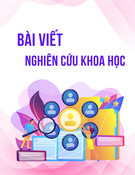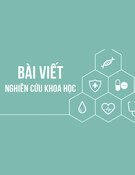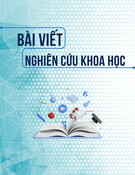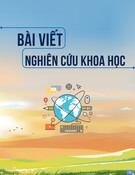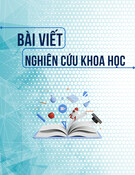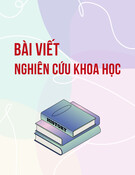
http://www.iaeme.com/IJMET/index.asp 1672 editor@iaeme.com
International Journal of Mechanical Engineering and Technology (IJMET)
Volume 10, Issue 03, March 2019, pp. 1672–1680, Article ID: IJMET_10_03_169
Available online at http://www.iaeme.com/ijmet/issues.asp?JType=IJMET&VType=10&IType=3
ISSN Print: 0976-6340 and ISSN Online: 0976-6359
© IAEME Publication Scopus Indexed
READABILITY LEVEL OF ARABIC TEXTS FOR
UPPER PRIMARY PUPILS AT AL-AMIN
ISLAMIC PRIMARY SCHOOL (SRI)
Nur Hidayah Hussain
Al-Amin Islamic School, Nilai, 71800 Negeri Sembilan, Malaysia
Maharam Mamat
Pusat Citra Universiti, Universiti Kebangsaan Malaysia,
43600 UKM Bangi, Selangor, Malaysia
ABSTRACT
Textbook has become one of the primary materials in the teaching of Arabic
language in Malaysia. Studies among scholars shown that the proficiency of Arabic
language among non-native students is still at a low level due to many factors including
the ineffectiveness of textbooks’ contents. Evaluation of a reading material takes into
consideration of many aspects including the readability level, which is the difficulty
level of a reading material. A quality textbook is a reading material that is easy to
understand. This study discusses the readability of Arabic texts among the upper
primary pupils in Al-Amin Islamic Primary School (SRI), Nilai, Negeri Sembilan. This
study of readability has a role for documentation to facilitates the Ministry of Education,
teachers, policymakers, textbook writers, and the related people in other fields.
Key words: Readability Level; Arabic Texts; Islamic Primary School; Al-Amin Nilai;
Malaysia Islamic School
Cite this Article: Nur Hidayah Hussain and Maharam Mamat, Readability Level of
Arabic Texts for Upper Primary Pupils at Al-Amin Islamic Primary School (SRI),
International Journal of Mechanical Engineering and Technology 10(3), 2019, pp.
1672–1680.
http://www.iaeme.com/IJMET/issues.asp?JType=IJMET&VType=10&IType=3
1. INTRODUCTION
The proficiency level of Arabic language among pupils in Malaysia is still at an average level
(Linamalini Mat Nafi & Kamarul Shukri Mat Teh 2014; Nik Mohd Rahimi, Sarizan Sulong &
Siti Nurhajariah 2016; Aisyah Sjahrony et.al 2017) and has yet to achieve the satisfactory level
(Zamri Ahmad & Ibtisam Abdullah 2014). Many pupils were not able to read Arabic texts
fluently even though the texts are easy, simple and provided with diacritical marks (Mohd
Zahimie & Hakim Zainal 2014). However, study by Awatif, Hairun Najuwah & Ku Fatahiyah
(2014) from the Islamic University College Selangor (KUIS) has shown that the proficiency
level of reading in Arabic language among students are at a high level.

Nur Hidayah Hussain and Maharam Mamat
http://www.iaeme.com/IJMET/index.asp 1673 editor@iaeme.com
Proficiency in Arabic language is influenced by how the process of teaching and learning
(teaching-learning) of the language is planned and executed. It should be compatible and has
flexibility for the teacher to apply and assist the pupil’s achievement (Mohd Ismail Mustari, et.
al 2012). This requires the work force of an expert, taken optional in Arabic language study, or
educated in teaching, at least a practical teaching in school. The lesson delivery should be eighty
percent in Arabic (Nazri Atoh, Saipolbarin & Mohd Zawawi 2014). According to Zunita et. al
(2016) and Ahmad Fuad (2015) the learning of Arabic language begins with the proficiency in
Arabic vocabulary that requires the optional teacher’s expertise. Traditionally, the learning of
Arabic vocabulary happens in the classroom using textbooks that become a foundation to the
language proficiency level (Awatif, Hairun Najuwah & Ku Fatahiyah 2014; Zunita et. al 2016).
2. PROBLEM STATEMENT
Textbook for learning Arabic is very important for the process of teaching-learning in school
as it contains facts, information and various topics that elaborate and classify the subject’s
syllabus in the curriculum (Leslie 2005). The readability of text will determine the compatibility
of the textbook to the capability and ability of the pupil’s comprehension (Aisyah Sjahrony,
Maimun Aqasha & Nik Mohd Rahimi 2017). The readability of reading text is needed to acquire
the reflection and positive involvement in the process of teaching-learning (Kamarulzaman
Abdul Ghani, Ahmad Sabri Noh & Nik Mohd Rahimi Nik 2017).
In Arabic, readability is defined as Maqru’iyyah or Inqira’iyyah (Tu’aymah & al-Thu’aybi
2006). It is a concept refers to the level or degree of difficulty for a reading material
(Muhammad Haron Husaini, et.al 2014; Kamarulzaman Abdul Ghani, Ahmad Sabri Noh & Nik
Mohd Rahimi Nik 2017). According to Chall (1974), the concept of readability contains three
aspects that are related to each other which are interest, easy to read, and easy to understand.
Dale and Chall (1948) explained readability as the extent to which the readers understand it,
read it at an optimal speed, and find it interesting. Many researchers including English (1958)
use the concept of a text “that makes it easy for any of a given class of persons to understand
its meaning”. In Malaysia, this concept is used by many researchers including Toeimah (1985),
Khadijah Rohani (1987) and Marohaini (1999).
According to Kamarulzaman Abdul Ghani, Ahmad Sabri Noh & Nik Mohd Rahimi (2017),
readability is an interactive process that takes place between the reader’s characteristics and the
reading text’s characteristics. According to Tay (2005), readability is different from the reading
ability. Readability focused on reading materials while reading ability focused on the individual
that reads. Marohaini (1999) classifies readability levels into three: first is Free Reading which
utilizes an easy-to-read or easy-to-understand text characterized by excellent comprehension,
excellent in identifying words, fluent reading rate and has only a few mistakes in all aspects.
Second is Lesson Reading which utilizes a text that is comfortable to the pupil characterized by
good comprehension, good in identifying words, average reading rate, and requires word
analysis for some words. Third is Futile Reading, which is a reading level that is too difficult
characterized by weak comprehension, not smooth and stuttered, and requires complete word
analysis caused by by difficulty.
Most of the students are having difficulty to understand Arabic text because of the lacking
proficiency in grammar and limited vocabulary (Harun Baharudin, Zawawi Ismail & Nik Mohd
Rahimi 2017). There is a need to refer to dictionary to know the meaning of the words that they
do not understand (Awatif, Hairun Najuwah & Ku Fatahiyah 2014; Ahmad Fuad 2015). Study
by Zunita et al (2016) and Khatijah Md Khatib & Hakim Zainal (2018) found that the
proficiency in Arabic is influenced by perfect vocabulary in terms of spelling, meaning, and the
correct usage of the word.

Readability Level of Arabic Texts for Upper Primary Pupils at Al-Amin Islamic Primary School (SRI)
http://www.iaeme.com/IJMET/index.asp 1674 editor@iaeme.com
Process of teaching-learning of Arabic requires skills in stages, which are listening, reading,
speaking, and writing. (Awatif, Hairun Najuwah & Ku Fatahiyah 2014; Zamri Ahmad &
Ibtisam Abdullah 2015). According to Rosni Samah et.al (2015) and Nor Mazidah Mahmood
(2012), using materials in Arabic and doing language activities are the most effective method
in learning secondary language. Learning Arabic requires memorizing grammatical rules and
words, communicating and interacting such as dialogues, listening to teacher’s reading without
looking at text, acting out and activities for writing skills in Arabic (Ahmad Ismail, et.al 2016).
The proper selection of strategy in teaching-learning will affect the achievement of Arabic
language among students. Linamalini Mat Nafi & Kamarul Shukri Mat Teh (2014) adopt a
strategy that is related to the religious obligations such as understanding and appreciate the
meaning of prayer recitation in daily prayers, supplications, Quranic verses or Hadith, and
correcting and improving the pronunciation of Arabic through Quranic recitation.
In the process of teaching-learning, textbook has become one of the crucial learning
materials. Good textbooks should contain things that would attract and motivate pupils to learn.
(Muhammad Izuan Abd Gani & Radziah Ismail 2015). Appropriate readability level is
necessary to attract interest and motivate pupils to continue using it (Salasiah Hanin Hamjah et
al. 2011) and increases the reading skill of students in the process of learning foreign language
(Kamarulzaman Abdul Ghani 2011).
Purpose and Limitations of Study
The purpose of this article is to measure the readability level of At-Taisir Arabic Language
textbook, which is being used in the Islamic Primary School (SRI) Al-Amin, Nilai, Negeri
Sembilan. This school is a primary school under the network of IKRAM-Musleh Education
which combine the national curriculum under Ministry of Education Malaysia and curriculum
of IKRAM-Musleh. At-Taisir Arabic Language is used by upper primary pupils and drafted
specially by a panel of authors in Education Division of IKRAM-Musleh and is used in every
primary school in IKRAM-Musleh’s network.
Text of At-Taisir Arabic Language
At-Taisir textbook has become a specialized reference for Arabic texts which is used in SRI Al-
Amin School, Nilai, but the readability test to identify the compatibility of the text has never
been done. The question related to the readability of pupils with this text emerged when the
pupils’ achievement of Arabic language is at a very disappointing level; the exam grades that
are very low and the inarticulate in reading Arabic text. Besides that, this study wants to identify
the compatibility of the text to the capability level of the pupil based on the comprehension
towards the text because a book that has been read will become a beneficial educational material
if it is understood correctly (Coleman 1962). A good text should be suitable, compelling, and
motivating to the reader (Dubay, 2002; Aisyah Sjahrony et. al 2017).
Since its establishment in 2013, Al-Amin Islamic Primary School Nilai adopt the national
curriculum under the Ministry of Education Malaysia, which is the Standardized Curriculum
for Primary School. This curriculum is called diniyyah curriculum which comprises subjects
such as Islamic Creed (‘aqidah), Islamic Jurisprudence (fiqh), Prophet’s Biography and Islamic
History (sirah), Arabic Language, al-Qur’an (Memorization and Recitation), tajwid (elocution),
and Jawi script. Islamization of knowledge are applied on every subject, philosophy, concept,
objective, and contents. Process of Teaching-learning in this school still fulfil the National
Education Philosophy and National Education Policy that emphasized twenty-first century
learning process. Year Six students in SRI Al-Amin Nilai will attend the Primary School
Evaluation Test (UPSR) which enables them to attend Islamic National Secondary School
(SMKA), High Performance School (SBT), MARA Junior Science College (MRSM), Fully

Nur Hidayah Hussain and Maharam Mamat
http://www.iaeme.com/IJMET/index.asp 1675 editor@iaeme.com
Residential School (SBP), and National Secondary School, and they will be given priority to
study in Islamic Secondary School Al-Amin of IKRAM-Musleh with the highest result of
UPSR. Year Six students must attend IKRAM Musleh Student Assessment System (SPPIM)
examination in July, with assessment only for Arabic Language subject, diniyyah and KRS.
Applied in SRI Al-Amin Nilai, IKRAM Musleh Student Assessment System (SPPIM) also
conducting a test called Endurance Test through observation of twelve constructs that being
held throughout the year, during weekly meeting, indoor and outdoor camping. The said
evaluation consists of 1A for written test, 1A for practical, 11A for competency construct and
1A for endurance. This assessment is drafted specially to achieve ten traits of an exceptional
Muslim such as true and straight belief, authentic worships, strong practice of virtues, morality,
and manners, independent, knowledgeable, strong and healthy physique, resistant to temptation,
organized in every matter, good time management, and generous and beneficial to others.
(IKRAM Organization Malaysia 2017)
IKRAM Musleh Education Curriculum was drafted according to the syllabus, Arabic
Language textbook and diniyyah. It’s been used in every branch of Al-Amin Islamic Primary
School, including SRI Al-Amin Nilai. According to Zairani A.Hamid et.al (2016), At-Taisir
Arabic Language is used from year one to year six. For pupil of year one until year three, At-
Taisir Arabic Language is including with extra activity book (based on the textbook syllabus).
Textbooks for year four, five, and six do not include activity books because the revision
questions in the textbooks are enough to encompass every topic. The contents in At-Taisir
Arabic Language textbook and activity book are different from the curriculum and syllabus of
Arabic established for Ministry of Education’s primary schools. At-Taisir Arabic Language
textbook or At-Taisir fil 'Arabiyyah is a six years Arabic Language program, designed for non-
native speaker primary school students. It contains fundamental knowledge of Arabic to
understand Arabic and Islamic culture, and Arabic for non-Arab (Shamsudin Mohamed Dom
2013). The contents are arranged thematically appealing according to ages such as:
1. Year 1 and 2: World of Self and Surrounding
2. Year 3 and 4: World of Information; Nature and Human
3. Year 5 and 6: World of Arabic and Islamic Culture
3. RESEARCH METHODOLOGY
Measurement for readability level of Arabic text has two methods, which is qualitative and
quantitative (Klare 1969; Gilliland 1972; Chall 1974; Harris & Sipay 1980). It covers literature
survey and analysis of past studies that are obtained through journals, conference paper, books,
research papers and thesis that will become supporting materials in the discussion. Besides that,
this research also utilizes questionnaire method and conducting measurements for readability
level of upper primary pupils based on the examination’s results throughout the school year.
Questionnaire
In this study, questionnaire is used as related information to the existing knowledge, motivation
and level of Arabic Language achievement among the pupils based on the studied text. It
identifies self-factors of pupils and their relations to readability of At-Taisir Arabic Language.
These questionnaires are distributed to all upper primary pupils in the IKRAM-Musleh schools
(Middle Zone – Negeri Sembilan, Selangor, Kuala Lumpur) to observe the similarities or
differences related to the readability among pupils.
Questionnaire used is of predetermined responses which is also known as structured
questionnaire or close ended questionnaire (Mohd Majid Konting, 2005). Respondents select
the preferred agreement level to show their impressions toward those statements (using Likert

Readability Level of Arabic Texts for Upper Primary Pupils at Al-Amin Islamic Primary School (SRI)
http://www.iaeme.com/IJMET/index.asp 1676 editor@iaeme.com
scale of five). This questionnaire is divided into a few sections. Information regarding pupil’s
motivation toward the Arabic Language reading text are divided into three categories, which
are: (a) intrinsic aspect of the reader which comprises of 7 items (a1 to a17); (b) extrinsic aspect
of the reader which comprises of 8 items (b8 to b15); and (c) the important of reading, which
amount to six items (c16 to c21).
4. LITERATURE STUDY
Muslich (2010) states that textbook is a book that is referred by students at a specific level as
instructional medium related to a specific learning field. Book is a primary source of
information in teaching-learning in Malaysia at every stage. Process of producing book as a text
for learning is still at the assumptions of the author and publisher without studying the
readability level of pupil ((Muhammad Haron Husaini 2012; Mohd Fadzli & Mohd Sukki 2012;
Kamarulzaman Abdul Ghani, Ahmad Sabri Noh & Nik Mohd Rahimi Nik 2017). However,
selection of a textbook that is incorrect and incompatibile with the comprehension level of the
pupil can cause failure to the process of teaching-learning (Aisyah Sjahrony, Maimun Aqsha
Lubis & Nik Mohd Rahimi Nik Yusoff 2017).
Textbook has become a primary reference even though the contemporary education system
already undergone great transformation and competition by various teaching aids devices that
are more appealing such as computer, television, internet, and other multimedia materials
(Affandi 2006; Mohd Nazri et al 2013). Studies conducted by Sanusi (2016) and Try Viananda,
Rina Alfah & Ibrahim (2018) have shown that learning the Arabic Language through online
using E-Learning method can increase the children’s interest to learn.
Textbook is used for communicative and grammar activities that are arranged in interesting
way to facilitate the learning of Arabic Language. Every chapter is provided with the modern
teaching approach and employed the suitable sentences. According to Zamri Arifin et al. (2013),
teaching and learning in Arabic language in Malaysia have yet to achieve the real aim and
objective due to the emerging problems during the process of teaching-learning. This has been
affecting the achievement of Arabic language among pupils in the primary school of IKRAM-
Musleh. At-Taisir Arabic Language textbook is one of the primary materials and has become a
reference for lower-level that is recognized by IKRAM-Musleh Curriculum and Ministry of
Education.
At-Taisir Arabic Language that has become a primary reference in SRI Al-Amin Nilai is
divided into two levels. Level 1 comprises of various subtopics such as Vocabulary Building
(Binaa al-Mufradat), Story Time (Waqt al-Qissoh), Conversation Game (Lu'bah Hiwariyyah)
and Exercise (Tatbiiqaat). Every subtopic is repeated two times, including different contents
related to the learned topic. Level 2 contains wider topics such as Prophets’ Stories, Historical
Places, Games, Jobs, and Animal Story. The textbook emphasizes towards the various aspects
of grammar, morphology, and vocabulary. Revision and exercise questions in the Arabic
Language Level 2 is more on the short essay answers based on the text. Besides that, the
questions that require pupil to use Higher Order Thinking Skills (HOTS). At-Taisir Arabic
Language Level 2 also contains elements such as;
1. Guided Reading (Al-Qira'ah Al-Muwajjahah): Comprehension questions that are
prepared before the reading as reading guidance for the pupils.
2. Dictionary Usage (Al-Qaamuus): Pupils are exposed to dictionary. Included in the text,
there are words in red on the column of this dictionary.
3. Brief Guide (Dalil Mukhtasar): A brief explanation is prepared for parents and teachers
in every page.




